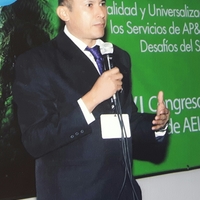
Jhonny I Pérez
Related Authors
Ahmad A Hanandeh
Yarmouk University
José Francisco Pessanha
UERJ - Universidade do Estado do Rio de Janeiro / Rio de Janeiro State University
Onur Toka
Hacettepe University
Frederick Harry Pitts
University of Exeter in Cornwall
Engr Sajid Chaudhary
University of Gujrat
Helena de Godoy Bergallo
UERJ - Universidade do Estado do Rio de Janeiro / Rio de Janeiro State University
Miressa Beyene
Haramaya university
Adnan Awad
The University Of Jordan
Jennifer Hulme
University of Toronto
Pablo Bahamonde
Universidad Tecnologica Nacional










Uploads
Papers by Jhonny I Pérez
the effluent and in midpoint either. Simulation results obtained with traditional models and developed it in this research was compared getting better fits to the experimental data.
processes and hydrodynamic aspects take place as characteristics of the flow,
mix regime, residence times and reactor geometry, otherwise, the conditions
for non-ideal flow as by-passing, dead zones and internal recirculation affect
their performance. This study deals with an evaluation of the hydraulic behavior
of a double-chamber anaerobic reactor (DCAR) of 534.5L (chamber 1=305L
and chamber 2=229.5L) as a technological innovation of the UASB reactors.
The DCAR was fed with Maracaibo, Venezuela municipal wastewater; each
chamber was inoculated with a granular, local brewery sludge (20% v/v).
The hydraulic evaluation was performed at the liquid phase and in operation,
using Li+ (LiCl) as a tracer applied in an instantaneous way at the affluent at
the theoretical hydraulic retention time (TRHt) of 6 hours; 3.4 in the chamber
number 1 and 2.6 in chamber number 2. The DCAR described as a plug flow
in both chambers and a hydraulic efficiency close to the unit (1), indicating an almost null presence of dead zones. The CDO (CDOT) of DCAR removal efficiency was kept in the range of 59.77% to 74.46% with an average of 68.26%. For chambers 1 and 2 the average efficiency was 60.4 and 20.94 with a biogas production (L/h) of 2.768 and 0.541 respectively.
the effluent and in midpoint either. Simulation results obtained with traditional models and developed it in this research was compared getting better fits to the experimental data.
processes and hydrodynamic aspects take place as characteristics of the flow,
mix regime, residence times and reactor geometry, otherwise, the conditions
for non-ideal flow as by-passing, dead zones and internal recirculation affect
their performance. This study deals with an evaluation of the hydraulic behavior
of a double-chamber anaerobic reactor (DCAR) of 534.5L (chamber 1=305L
and chamber 2=229.5L) as a technological innovation of the UASB reactors.
The DCAR was fed with Maracaibo, Venezuela municipal wastewater; each
chamber was inoculated with a granular, local brewery sludge (20% v/v).
The hydraulic evaluation was performed at the liquid phase and in operation,
using Li+ (LiCl) as a tracer applied in an instantaneous way at the affluent at
the theoretical hydraulic retention time (TRHt) of 6 hours; 3.4 in the chamber
number 1 and 2.6 in chamber number 2. The DCAR described as a plug flow
in both chambers and a hydraulic efficiency close to the unit (1), indicating an almost null presence of dead zones. The CDO (CDOT) of DCAR removal efficiency was kept in the range of 59.77% to 74.46% with an average of 68.26%. For chambers 1 and 2 the average efficiency was 60.4 and 20.94 with a biogas production (L/h) of 2.768 and 0.541 respectively.
- No existió la posibilidad de opinar globalmente sobre la conveniencia o no del proyecto; a nivel local solo se solicitó a la Corporación Autónoma Regional de La Guajira (Corpoguajira) la autorización de algunos permisos, pero no tiene sentido expresar un parecer al respecto si tomados aisladamente, sin un análisis del proyecto en su globalidad.
- Material en que basa esta opinión: documento divulgativo, sitio web www.cerrejon.com , visita al Arroyo el día 23 abril 2015, documentación técnica brindada por Cerrejón (ver lista de informes al final del documentos).
extender un agujero de unos 200 metros. La comunidad se
opone por razones muy diversas, pero hay una razón muy firme
que interesa a todos los colombianos, aunque estos no lo sepan.
especialmente para el tratamiento de las aguas residuales industriales. El UASB se fue expandiendo por todo el mundo debido a su alto nivel de aceptación especialmente en los países de clima tropical y subtropical. En este tipo de reactor, el agua residual entra por el fondo donde se inicia la degradación de la materia orgánica al estar en contacto con el consorcio bacteriano presente en el lodo, generándose como producto principal gas metano. El reactor tiene 3 partes esenciales: lecho y manto de lodo, donde existe un fuerte mezclado debido a la velocidad de entrada y al biogas generado, seguida de la zona de sedimentación que facilita el retorno de los lodos, debido al aquietamiento generado por el
separador trifásico (gas-sólido-líquido).
optimizarlos. En el presente trabajo se evaluó el comportamiento hidráulico, remoción de materia orgánica y microorganismos patógenos de un reactor anaerobio de doble cámara (RADCA) constituido por dos reactores UASB en serie. El RADCA es una innovación tecnológica de los reactores UASB, este se evaluó a escala piloto y condiciones mbientales tratando aguas residuales municipales (ARM) a TRH de 12, 10, 8 y 6 h, El volumen del RADCA fue de 534,5 L (cámara R1=305 L y cámara R2= 229,5 L), se utilizó como substrato agua residual municipal ARM. Para conocer el tipo de flujo del sistema se utilizó cloruro de litio como
trazador; en una primera fase utilizando agua de grifo sin inoculo y en una segunda fase en operación (ARMlodo-
biogás) a TRH de 6h .Las cámaras R1 y R2 presentaron un comportamiento hidráulico de flujo disperso (d ≥ 0,20), excepto para la cámara R2 en la fase líquida, la cual presentó comportamiento flujo pistón. los valores menores del efluente en DQO total (DQOT), DQO soluble (DQOS) y DBO5-20 se presentaron en el RADCA a TRH 10h registrando valores promedio de 72 ± 24, 39 ± 21 y 64 ± 13mg/L, respectivamente, estos valores representan eficiencias promedio de 78 ± 7, 58±20 y 62 ± 5%, para los parámetros antes citados, las
menores concentraciones de los SST en el efluente se obtuvieron a TRH de 12 y 10h registrando promedios de 39 ± 21 y 47 ± 12mg/L, respectivamente. Se alcanzaron eficiencias en la remoción de coliformes totales y fecales de 66,252 y 61,117%, respectivamente, en el TRH de 10h. Con base en los resultados obtenidos; el RADCA se constituye en una innovación tecnológica viable, para el tratamiento de las ARM.
anaerobic reactor (RADCA). RADCA is a technological innovation of UASB reactors, it was inoculated with granular sludge (20% v/v), used as substrate synthetic wastewater and was evaluated hydraulic retention time (HRT) of 12, 10, 8, 6, 4, 3 and 2 h. The reactor volume was
12L, (R1 = 7.5 L and chamber R2 = 4.5 L). Was determined the most efficient in terms of organic matter removal and biogas production. The average of removal efficiency of COD was 84 and 85% for the HRT of 10 and 8 h, respectively, achieving efficiencies of 60 and 59% for R1 and R2
cameras on HRT of 10 h, for 8 h TRH was 72 and 46%. Biogas production increased significantly as the HRT was decreased, reaching 520 ml / h, with a methane percentage higher than 70%. Based on the results the RADCA constitutes a viable technological innovation for the
treatment of municipal wastewater.
the evaluation phase parameters were monitored: temperature, pH, alkalinity, index buffer (IB), BOD5, COD, biogas production, SST, ST, which were determined according to standardized rules established in APHA. The maximum removal efficiency of the organic load was 73.0% and
67.3% in terms of COD and BOD respectively obtained HRT of 6 hours. The sludge presented adequate adaptation to waters with low organic loads and environmental conditions typical of this area.
(subsistence food) and water (use and development of water supply structures, distribution and risk index Water Quality (IRCA)). As strategies, was designed a photovoltaic system for operating a hybrid model solar pumping - windmill for water supply; itself a demonstration plot to evaluate different irrigation techniques and to encourage subsistence food was built. The results reflected the social ownership
and empowerment of technology, benefiting 23 families (115 people) trained in different aspects of the study, the construction of storage facilities and distribution of water resources conditions improved accessibility, quality and control water, corroborated with the IRCA which established a state for human consumption. The measures allowed the social field management involving indigenous perception on the impact of climate change and adaptation to joint ownership of technology and
innovation.
chaos, this is exacerbated in times of heavy rain as is happening with climate change. The purpose of the project MODCEL (modeling in cell) was to find alternative solutions to deal with flooding in the urban area of the Riohacha city. To make the simulations was previously necessary to conduct a survey to 450 households to get relevant information related to the type of housing, socio-economic characteristics, level of flood occurred in 2011. Through a participatory process, supported by an evaluation multicriteria type, an integrated flood and urban plan prior analysis of alternative Alternative 3 including structural and non-structural measures selected was generated, highlighting the use of particular elements of the territory as wetlands present in the study area (natural and anthropic).
entradas impares (5, 7, 9, 11, 13 y 15) con to de 5 horas. La
eficiencia de remoción de DQO permaneció casi constante
cuando el sistema operó con 3 entradas (cercano al 30%), e
incrementó con el número de ellas hasta un máximo de 62.5%
y 62.2% para la DQOt y DQOs respectivamente. Los SST y
SSV se incrementaron de 39.2% y 35.9% hasta 50.3 % y
49.7% respectivamente. Los parámetros de control como pH,
índice Búfer (IB), ácidos grasos volátiles (AGV) permanecieron en los rangos favorables para la digestión
anaerobia.
calibration a physical model with a prototype, as performed in this study. Assays were performed on a physical model (FM) constructed in reduced scale 1:8 between prototype (UASB based in Geneva, Colombia) and MF. The reactor was fed with municipal wastewater. Tracer study with Li+ (LiCl) was used. The relationship relative length (Lr) for the physical and kinematic similarity was 0.1239 and dynamic, Lr = 0.1290. was obtained an overlapping of the distribution residence times (DRT) to a hydraulic retention time theoretical (to) 5 h. Hydraulic efficiencies (β) obtained ranged from 0.798 to 0.988 in the MF and0.902 to 0.943 in the prototype.